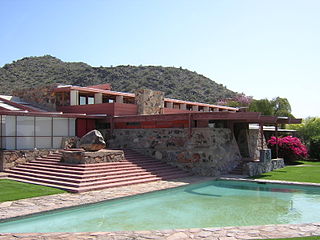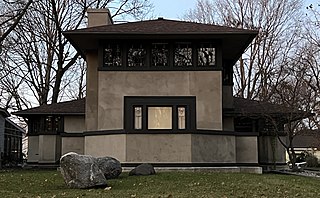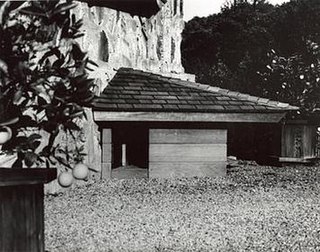
Frank Lloyd Wright Sr. was an American architect, designer, writer, and educator. He designed more than 1,000 structures over a creative period of 70 years. Wright played a key role in the architectural movements of the twentieth century, influencing architects worldwide through his works and hundreds of apprentices in his Taliesin Fellowship. Wright believed in designing in harmony with humanity and the environment, a philosophy he called organic architecture. This philosophy was exemplified in Fallingwater (1935), which has been called "the best all-time work of American architecture".

Fallingwater is a house designed by the architect Frank Lloyd Wright in 1935 in the Laurel Highlands of southwest Pennsylvania, about 70 miles (110 km) southeast of Pittsburgh in the United States. It is built partly over a waterfall on Bear Run in the Mill Run section of Stewart Township, Pennsylvania. The house was designed to serve as a weekend retreat for Liliane and Edgar J. Kaufmann, the owner of Pittsburgh's Kaufmann's Department Store.
Charles Kushner is an American real estate developer and disbarred former attorney. He founded Kushner Companies in 1985.

Taliesin, sometimes known as Taliesin East, Taliesin Spring Green, or Taliesin North after 1937, is a historic property located 2.5 miles (4.0 km) south of the village of Spring Green, Wisconsin, United States. It was the estate of American architect Frank Lloyd Wright and an extended exemplar of the Prairie School of architecture. The expansive house-studio set on the brow of a ridge was begun in 1911; the 600-acre (240 ha) property was developed on land that previously belonged to Wright's maternal family.

Unity Temple is a Unitarian Universalist church in Oak Park, Illinois, and the home of the Unity Temple Unitarian Universalist Congregation. It was designed by the American architect Frank Lloyd Wright, and built between 1905 and 1908. Unity Temple is considered to be one of Wright's most important structures dating from the first decade of the twentieth century. Because of its consolidation of aesthetic intent and structure through use of a single material, reinforced concrete, Unity Temple is considered by many architects to be the first modern building in the world. This idea became of central importance to the modern architects who followed Wright, such as Ludwig Mies van der Rohe, and even the post-modernists, such as Frank Gehry. In 2019, along with seven other buildings designed by Wright in the 20th century, Unity Temple was added to the UNESCO World Heritage List.

Taliesin West was architect Frank Lloyd Wright's winter home and studio in the desert from 1937 until his death in 1959 at the age of 91. Today, it is the headquarters of the Frank Lloyd Wright Foundation.

Prairie School is a late 19th and early 20th-century architectural style, most common in the Midwestern United States. The style is usually marked by horizontal lines, flat or hipped roofs with broad overhanging eaves, windows grouped in horizontal bands, integration with the landscape, solid construction, craftsmanship, and discipline in the use of ornament. Horizontal lines were thought to evoke and relate to the wide, flat, treeless expanses of America's native prairie landscape.

American Craftsman is an American domestic architectural style, inspired by the Arts and Crafts movement, which included interior design, landscape design, applied arts, and decorative arts, beginning in the last years of the 19th century. Its immediate ancestors in American architecture are the Shingle style, which began the move away from Victorian ornamentation toward simpler forms, and the Prairie style of Frank Lloyd Wright.

Jared Corey Kushner is an American businessman, investor, and former government official. He is the son-in-law of former president Donald Trump through his marriage to Ivanka Trump, and served as a senior advisor to Trump from 2017 to 2021. He was also Director of the Office of American Innovation.

The Nathan G. Moore House, also known as the Moore-Dugal Residence, is a house designed by Frank Lloyd Wright. The house was built one block south of Wright's home and studio at 333 Forest Avenue in the Chicago suburb of Oak Park, Illinois. It was originally completed in 1895 in the Tudor Revival style at the request of client Nathan Moore. Wright obliged his client's wishes, but long after disliked the house for its adherence to historical styles.

The K. C. DeRhodes House was built for newlyweds Laura Caskey Bowsher DeRhodes and Kersey C. DeRhodes in 1906 by Frank Lloyd Wright. It is a Prairie style home located at 715 West Washington Street in South Bend, Indiana. The home was carefully restored by Tom and Suzanne Miller over more than four decades and remains in private ownership. It is one of two Wright homes in South Bend, the other being the Herman T. Mossberg Residence. It is one of eight Frank Lloyd Wright designed homes in Indiana, of which seven remain. It was also the first home Frank Lloyd Wright built in Indiana.

The Edward E. Boynton House (1908) was designed by Frank Lloyd Wright in Rochester, New York. This privately owned prairie-style home was commissioned by widower Edward Everett Boynton and his teenage daughter Beulah Boynton. According to Beulah Boynton it cost her father between $45,000 - $50,000 for the house, the lot and the contents - a staggering sum in 1908. This two-story, approximately 5,500 square foot home, was originally situated on an acre lot in the city of Rochester. Seventeen pieces of original Frank Lloyd Wright furniture remain in the house.

In architecture, an overhang is a protruding structure that may provide protection for lower levels. Overhangs on two sides of Pennsylvania Dutch barns protect doors, windows, and other lower-level structures. Overhangs on all four sides of barns and larger, older farmhouses are common in Swiss architecture. An overhanging eave is the edge of a roof, protruding outwards from the side of the building, generally to provide weather protection.
The Carlton D. Wall House, also known as Snowflake, is a Frank Lloyd Wright designed home in Plymouth Township, Michigan. It is one of Wright's more elaborate Usonian homes. In 1941, recently married Mr. and Mrs. Carlton David Wall, who were Wright's youngest clients, approached Wright to design a house for them after Carlton Wall studied Wright's architecture in college.

The Robert M. Lamp House is a residence built in 1903 two blocks northeast of the capitol in Madison, Wisconsin, designed by Frank Lloyd Wright for his lifelong friend "Robie" Lamp, a realtor, insurance agent, and Madison City Treasurer. The oldest Wright-designed house in Madison, its style is transitional between Chicago School and Prairie School. In 1978 the house was added to the National Register of Historic Places.

David Downing is a British author of mystery novels and nonfiction. His works have been reviewed by Publishers Weekly, The New York Times, and The Wall Street Journal. He is known for his convincing depictions of World War II and Berlin. He has written a series of espionage thrillers, based around Anglo-American character John Russell exploring Germany in the 1940s. They are known as "The Station Series" because they are all named after train stations, mostly in Berlin.

Eddie's House was a doghouse designed by Frank Lloyd Wright for the Berger family of San Anselmo, California, to be used by their dog Eddie. Wright designed Eddie's House to be in keeping with the family's home, known as the Robert Berger House, which he had previously designed. The plans for the doghouse were completed by Wright in 1957, and the 4 sq ft (0.37 m2) triangular house was built in 1963. In 1973 Eddie's House was removed and thrown away, but in 2010 Jim and Eric Berger, sons of Robert Berger, rebuilt Eddie's House from the original plans for a segment in Romanza, a documentary film by Michael Miner about Frank Lloyd Wright's architectural works in California. The doghouse remains the smallest structure Frank Lloyd Wright ever designed.

The family of Donald Trump, 45th president of the United States (2017–2021) and owner of The Trump Organization, is a prominent American family of German and Scottish descent. They are active in business, entertainment, politics, and real estate. Donald Trump, his third wife Melania, and their son Barron were the first family for the duration of his presidency. Trump's father Fred was the son of German immigrants, while his mother Mary Anne MacLeod was a Scottish immigrant. Trump has five children from three wives and ten grandchildren.

"A Fireproof House for $5000" is an article and house design by Frank Lloyd Wright published in the Ladies' Home Journal in April 1907. It is Wright's third and final publication in the journal following "A Home in a Prairie Town" and "A Small House with 'Lots of Room in It'" from February and July 1901, respectively. The drawings for the house were also included in Wright's 1910 Wasmuth Portfolio (Plate XIV).

Mrs. Clinton Walker House, also known as Cabin on the Rocks, is located on Carmel Point, near Carmel-by-the-Sea, California. It has the appearance of a ship with a bow cutting through the waves. The house was designed by Frank Lloyd Wright in 1948 and completed in 1952 for Mrs. Clinton "Della" Walker of Pebble Beach. It was listed on the National Register of Historic Places on November 17, 1977.


















